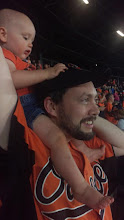Fun facts about Russ Snyder:
-Born in Oak, NE, he signed with the Yankees as an amateur free agent in 1953.
-Despite a strong batting record at every stop in the minors (including an eye-popping .432 in 138 games in his first pro season at class D McAlester), Russ moldered in the stacked New York farm system for six seasons before he was mercifully dealt to the Athletics.
-Finished third in Rookie of the Year voting in 1959 even though he played in just 73 games. Hit .313 with a .367 on-base percentage in his first crack at American League pitching.
-After a sophomore slump, Snyder was sent to the Orioles in a six-player trade. Though he was a part-timer for much of his tenure in Charm City, he was a valuable role player, including batting averages of .305 in 1962 and .306 in 1966. He ranked third in the A.L. with 18 steals in 1963.
-On April 29, 1962, Russ achieved a rare feat by delivering two pinch-hits in one inning. Facing Kansas City, he batted for pitcher Wes Stock and led off the seventh inning with a game-tying home run. The O's batted around and tacked on four more runs, allowing Snyder to come to the plate again with two runners on base. He delivered an RBI single, putting the cap on a six-run rally.
-Capped his career-best 1966 season by appearing in Baltimore's four-game World Series sweep of the Dodgers. He reached base three times in eight trips to the plate and had and RBI single against Don Drysdale in Game One.
-Spent the last three years of his career with the White Sox, Indians, and Brewers before retiring in 1970. In a dozen seasons in the majors, he hit .271 with 150 doubles, 42 home runs, and 319 RBI.
-Hit his final home run off of future Hall of Famer Catfish Hunter. In total, he took Hunter deep three times, tying his career high against any pitcher. He victimized another Cooperstown denizen (Jim Bunning) thrice, and also performed the feat against 215-game winner and three-time All Star Jim Perry.
-Other interesting tidbits: Frank Robinson once doubled, but was called out when baserunner Snyder passed him going the other way (he assumed the blast to the center field fence had been caught and was retreating); against the Senators, he once scored from second base on a flyout; and in 1966, he caught the final out of the game that allowed the Orioles to clinch their first pennant.
-Post-baseball, Russ went home to Nelson, NE and operated a tavern/steakhouse for a decade before working for the Government Soil Conversation Office.


